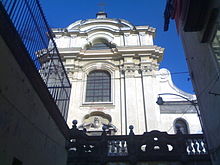Santi Severino e Sossio, Naples
| Church of Santi Severino e Sossio | |
|---|---|
| Chiesa dei Santi Severino e Sossio | |

The façade of church.
|
|
| Coordinates: 40°50′52″N 14°15′30″E / 40.847764°N 14.258294°E | |
| Location | Via Bartolommeo Capasso Naples Province of Naples, Campania |
| Country | Italy |
| Denomination | Roman Catholic |
| Architecture | |
| Status | Active |
| Architectural type | Church |
| Style | Baroque architecture |
| Administration | |
| Diocese | Roman Catholic Archdiocese of Naples |
The church of Santi Severino e Sossio and the annexed monastery are located on via Bartolommeo Capasso in Naples, Italy.
The church is attached to one of the oldest monasteries in the city, and from 1835 it has housed the State Archives of Naples. It was founded in the tenth century by the Benedictine Order, but the Saracen raids of the time forced them to abandon the old monastery, located on the hill of Pizzofalcone, taking the relics of San Severino with them. In 904 they added to these the relics of San Sossio, martyred companion of San Gennaro. They remained here till 1808, when they were taken to Frattamaggiore.
During the Angevin reign a number of important events occurred in this monastery, such as the convening of parliament in 1394 by the Sanseverino family, who were supporters of Louis II of Anjou. In 1490, the architect Giovanni Francesco Mormando from Calabria laid the foundations of the present church, which was completed by the 16th century by Giovanni Francesco di Palma. The cupola built in 1561 was one of the first in Naples, designed by the Florentine architect Sigismondo di Giovanni.
The frescoes of the cupola (1566), now lost, were originally painted by a Flemish painter by the name of Pablo or Paolo Schepers. Other painters active in the church comprised a polyglot series of artists, including Marco Pino of Siena, Benvenuto Tortelli of Brescia, Bartolomeo Chiarini of Rome, Cosimo Fanzago of Bergamo, and lastly Fabrizio di Guido from Carrara. The last painter was active in the Medici chapel. .
There is a long tradition of Tuscan artists residing in Naples, and was stimulated by the arrival of a group of master artisans from Carrara in the late 1500s, after the marriage of Alberico Cybo Malaspina and the Neapolitan Isabella of Capua, from the Duchy of Termoli. But there had already been a large contingent of Tuscan traders and financiers in Naples. For example, Antonio Piccolomini used the Strozzi family to negotiate having Antonio Rossellino and Benedetto da Maiano participate in the decoration of the Piccolomini Chapel in the church of Sant'Anna dei Lombardi. In addition, Tino di Camaino and Giotto apparently visited Naples under Angevin patronage.
...
Wikipedia
